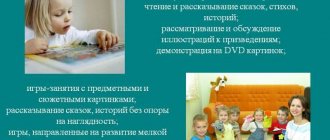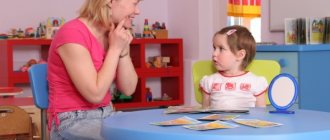Speech development of children 2-3 years old
In the speech of a child of the third year of life, the sounds [s'], [l'], [th'], as well as [g], [x], [k], [m], [p], [b] should appear. , [n], [v], [f], [d], [t], and, of course, all vowels.
Although the pronunciation of many sounds is still very far from ideal, this is due to the mobility of the muscles of the tongue and lips, which are not yet sufficiently developed. The child replaces most difficult sounds with easier ones to pronounce. So, the baby replaces hissing sounds with whistling sounds: “tsai” (tea), “zyuk” (beetle). A child’s vocabulary expands quickly, reaching approximately 300 words by the age of two, and up to 1000 words by the age of three. By the third year of life, the baby enjoys listening to simple fairy tales and stories, and easily carries out simple verbal instructions. By the age of 2.5 years, the baby should already have developed phrasal speech; phrases often consist of two words “mama give”, “mama pi”. But do not sound the alarm if your child does not start speaking at two years old, this is all very individual and often children begin phrasal speech by the age of three. The age of two or three years is considered the most critical and it would not be out of place to see a specialist in the absence of phrasal speech.
Why do sounds appear at different ages?
The development of a child’s speech requires the active inclusion of a huge number of different processes: the development of hearing and vision, memory, thinking, attention, training the muscles of the tongue and lips. Try pronouncing the sounds [a] and [r] and compare how much more control and skill the second sound requires, while the first is pronounced without complex movements of the tongue and lips. It is not surprising that the sound [r] can appear in a child several years after the appearance of speech, because it takes a lot of practice for the child to understand how to pronounce and use such a complex unit of speech.
Unfortunately, to produce complex sounds, some children may require the help of a specialist: anatomical features, unclear speech of the parents themselves, and other features of the child’s environment and development can lead to the fact that children need a special exercise program and supervision from a speech therapist and doctors.
The question arises, how to recognize whether a child needs a speech therapist to correct sound pronunciation or whether he just needs to read more and learn poetry? To do this, parents need to understand and analyze four things:
- General stages of development of sound pronunciation in children. For example, the sound [c] most likely will not appear before the sound [t], children under three years old can be forgiven for softening their consonants, and the sound [r] can only be formed by the age of five or six.
- Environment. When a child learns, he takes the speech of the people around him as a basis, so if dad “swallows” the endings of words, mom lisps, grandma burrs, and grandpa has a lisp, the child has every chance to collect a full bouquet of sound pronunciation disorders. It should also be remembered that babies born into bilingual families tend to mix the sounds of different languages.
- Health and anatomical features of the child. Birth injuries, hearing impairment, malocclusion, unusual structure of the palate, as well as general susceptibility to disease can become a serious obstacle to the development of speech and are often insurmountable without the support of specialists.
- Features of education. Children whose parents do not pay enough attention to their speech may get used to pronouncing sounds incorrectly, but those children who receive too many comments tend to simply skip complex sounds, trying not to run into criticism once again.
If a child has difficulties in one or more categories (for example, the baby is far behind age norms or is surrounded by adults with speech impediments), it is worth consulting with specialists and getting recommendations on the development of the baby’s speech and sound pronunciation.
Remember, any developmental disorders are corrected more easily and quickly if work begins immediately after their appearance, so you should not delay a visit to a children's speech therapist, psychologist or doctor if something worries you about the baby's development.
Speech development of children 3-4 years old
Children of this age constantly ask adults questions that should not be ignored. We must patiently and easily answer all the “why?”, “why?” And How?". Children of the fourth year of life correctly pronounce whistling sounds. At this age, they cannot always pronounce hissing sounds correctly; they often replace them with whistling sounds: “kasa” (porridge). Children can replace sonorous sounds with a soft sound [l'] or [th]: “leka” (river), “yobot” (robot). This age is characterized by omissions or rearrangements of sounds in speech, as well as syllables, for example, the fairy-tale hero kolobok can sound like “kobolok” in children’s speech, a dog can sound like “kabaka”. By the age of four, vocabulary doubles. Children are allowed to incorrectly use prefixes, endings, suffixes, and word agreements in a sentence (for example, “I’m putting on my belt”).
Can sounds stand up on their own?
About the sounds of early ontogenesis, we read the post “Speech (for information)” - these sounds, as a rule, really arise on their own.
“What interferes with the development of speech” (about the delayed start of speech in children) A small digression: in the last five to seven years I have observed a more frequent absence than before in the speech of children over 3 years old of the sounds T/D or K/G, more precisely, replacing one pair of sounds with another: “Goose = Dus, House = Gom, duck = uKka” or vice versa, “Cat = Tot, Slippers = Kapki, uTKa = uTTa.” Despite the fact that we pronounce the soft derivatives of these sounds (t/d; k/g) clearly, for example: “DeTi, Kisa.” In general, softening all consonants at an early stage is the norm.
Solid D/t H/c can be installed relatively quickly and easily by specialists!
Let's return to the main topic of the post))
We will talk about speech, not burdened by neurology (for example, with dysarthria you cannot do without a good speech therapist)
New “norms”, according to which, for example, the sound P and Pb can be waited up to 7 years, will be left to normative specialists, methodologists and theorists. I am a practitioner and, without entering into polemics with them (and their adherents)), I do not insist, but share exclusively my vision, based on my own experience)) So:
Can sounds stand up on their own? They can, and this is not uncommon)) But in a number of cases, and there are many of them, hopes for a while are not justified ((
* Hope #1:
interdental pronunciation will return to normal on its own. The answer is no, it won’t work. The habit is persistent and requires correction, and interdental pronunciation also changes the aesthetics of speaking, and this is important! Imagine that you have always written with your right hand, why suddenly you write with your left?
* Hope #2. Distorted sibilants (for example, buccal production) will correct themselves. The answer is no, it won’t get better without correction. See #1.
If the sibilants are not distorted, and they are not there at all until 4.5, most likely they are replaced by Ш=с, Ж=з can stand up on their own only if you “adjust” the language.
* Hope#3. Sonorous Ll. Can we wait until 6 years? We can if we want and hope, but is it necessary? Often, with the anatomical norm, the sound L appears in speech on its own (Lev, ULitka, Sol) - Hurray!)) In a scenario where L is present, but l is not, I would say, wait, perhaps it will stand up on its own, but I would pay attention to tone up! language.
In the opposite case, when L-is in place, but the sound L is not (Boat = Yodka / UODka / Vodka, take-take/takeU/takeV/take..), if the child is ready for classes, as such, you can put in 4d - thereby eliminating possible problems when recognizing letters, otherwise the letter L will sound the same as B or U (depending on the variant of the defect), and when writing words at 5-6 years old, it will generally disappear from words ( volk = vo.k), because we write as we hear the word within ourselves, and not as they dictate to us.
Hope#4. The most common one is to wait until he roars. It happens quite often!)), if the hyoid frenulum is not shortened and the tongue is “tuned” to rise and hold.
But more often, children aged 4.5-6 years, if they have not been correctly assigned R/R, begin to look for vibration themselves and find it! it... not where it should be, but in the throat ((And we get a uvular (guttural sound), which is more difficult and longer to get rid of than the absence or replacement of sound (Raketa = Laketa/Yaketa). Therefore, if you are not sure that the sound will be clear, if you want to call it, don’t just ask to growl, it can cause harm.
If there is a hard, clean R (Robot, boat, fly agaric), but there is no soft one (River = Echka, door = dveY), then you can pull it out, relying on the existing one, but with your help or a speech therapist.
A fairly common question: “How often do you need classes with a speech therapist?” Answer: This will largely depend on speech!! diagnosis (presence or absence of neurological problems), the number of defective sounds, and the experience of the specialist.
Is your child ready for speech therapy classes, to receive information and new skills, at what age to start sound correction, to make sounds or not, to wait or not to wait, to be or not to be)) - it’s up to you to decide!
Actually, hope is a good feeling, especially if it is backed by action!
Take action and be healthy!
PS: “He can, but he doesn’t speak...”
"Exit from Babble":
“Violation of the syllabic structure of a word”:
“FFNR or what to do?”
Speech development of children 4-5 years old
In five-year-old children, coherent speech becomes more varied and colorful.
At this age, children pronounce hissing sounds [w], [z] more purely and clearly; most children begin to correctly pronounce the sound [l] and more complex [r], [r']. Children of the fifth year of life are able to recognize the sound in a word, and can also select several words with a given sound. Able to distinguish words that differ in one phoneme: kidney-barrel.
Vocabulary increases to 3,000 words by the age of five. At this age, the child is able to coherently talk about any events and compose a story based on a series of plot pictures. Retell a short text that is familiar to him.
Speech development of children 5-6 years old
This age is an important point in preparing children for school. The child must be able to express his thoughts coherently and in the correct sequence. After five years, vocabulary grows rapidly. It is no longer possible to count the number of words used. Sound analysis skills have been developed. When preparing for school, children should be able to correctly determine the position of a sound in a word: the beginning, middle, end of a word, the exact place of a sound in a word, and also name all the sounds in order in a word. Children may experience errors in the use of plural forms of nouns, in the nominative and genitive cases: ball - no balls, one ear - many ears.
Normally, children of this age should clearly pronounce all sounds at the level of words and sentences. Unfortunately, this does not always happen. Most children have deficiencies in sound pronunciation associated with disturbances in the structure and mobility of the articulatory apparatus or with underdevelopment of phonemic hearing.
In these cases, parents should urgently contact a speech therapist so that the specialist can determine the cause of the incorrect sound pronunciation and carry out corrective work. The later parents seek help, the longer they will wait for results. The older the child gets, the more strongly the incorrect sound pronunciation is consolidated in his speech, the longer the period of automation of the delivered sound in speech will take.
Consultation for parents “Norms for the appearance of speech sounds in a child”
Natalia Putilova
Consultation for parents “Norms for the appearance of speech sounds in a child”
From two months, the child begins to pronounce the so-called “pseudo-speech”
sounds : “agu”
,
“aha”
,
“ugi”
. This is a romp. This period lasts approximately 5 months.
Normally, humming smoothly flows into babbling (if the child has preserved hearing and intelligence)
- pa-pa-pa, ma-ma-ma, ha-ga-ga, boo-boo-boo, etc. The babbling lasts up to 10-12 months.
By the age of 2, the child should master and clearly pronounce vowel sounds : [a], [u], [o], [i] and consonants: [k], [k'], [g], [g'], [m ], [m'], [p], [p'], [b], [b'], [t], [t'], [d], [d'], [n], [n' ].
Words appear in speech.
If RRD occurs - delayed speech development, you should consult a speech therapist in a timely manner in order to avoid deep systemic underdevelopment of speech .
By the age of 3, the child masters the sounds [v] , [v'], [f], [f'], [s], [e], [x], [x'], [s'], [z'] , [l'] and speaks phrasal speech (builds sentences of 3-5 words)
.
Up to three years, the age norm is considered to be softening of consonant sounds ( “syapka”
instead of
“hat”
,
“dem”
instead of
“house”,
etc.).
sounds gradually disappears ( normally, during this period the child stops saying “dem”
and pronounces clearly
“home”
).
The baby masters iotized sounds (for example, in the words “skirt”
,
“south”
,
“hole”
).
By the age of four, most children correctly pronounce whistling sounds : [s], [s'], [z], [z'] (the tongue should not be between the front teeth)
and distinguishes them well in free
speech .
After 4 years , the child correctly pronounces in speech and differentiates (distinguishes)
sounds, without exception, are already interconnected ([s], [s'], [z], [z'] and [ts])
.
At this age, a violation of the pronunciation of the sounds [w] , [zh], [sch], [h], [l], [r], [r'] is still possible. A child normally easily identifies and names the stressed vowel at the beginning of words: for example, in the words “duck”
,
“stork”
,
“cloud”
;
can determine and name the order of sounds in mergers : ay, ua, ia.
At the age of 5 years there are already hissing sounds ([w], [zh], [sch], [h])
are pronounced
correctly by the child , and they are also differentiated by
him in free
speech . Many children master the sound [l] .
The sounds [r] and [r'] also appear in children in a timely manner by the age of 5.5 years. For this, the work of all muscles of the speech apparatus is important. A child at this age can easily determine the initial and final sounds in words , can determine the number of sounds in a three-syllable word , and can choose a word for a given sound .
By the age of six, the child correctly pronounces and differentiates in speech all the sounds of his native language . He can determine the place of any sound in a word , determine the number of sounds in a word , and select a word for a given sound . Dear adults, remember that your child’s oral speech is important for the successful development of written speech .
It is necessary to eliminate speech defects in a timely manner.
Correct, well-developed speech is one of the main indicators of a child’s readiness for successful learning at school.
Speech development of children 6-7 years old
Children of this age are ready for systematic learning. By the age of six, children clearly distinguish by ear all the sounds of their native language: deaf - voiced, hard - soft.
The vocabulary of preschool children of six or seven years old is quite large and can no longer be counted, especially since there is a large gap in quantitative terms among children with different speech development: there are children with a rich vocabulary, very knowledgeable in different areas of knowledge, and there are children whose vocabulary very poor and limited to everyday topics. Children of this age can independently compose a story based on a series of plot pictures, retell a fairy tale read to them, and tell their impressions of a cartoon they watched.
Unfortunately, many parents believe that they should not interfere with the process of speech formation. Like, the child will grow up and everything will work out for him on his own, he will learn to speak correctly. My parents believe that in our childhood there were no speech therapists, and they learned nothing, and my child will learn. This is a wrong opinion! I hope you can correctly assess the level of speech development of your baby. And take the necessary steps towards the successful speech development of your child!
Recommendations for developing a child’s correct speech
We have already mentioned that the development of a child’s pronunciation and his speech in general depends on his physical condition and the environment in which he develops, so your actions towards the baby directly affect the development of his speech. What points should be taken into account?
Be attentive to your child's health
Take care of your baby’s health, monitor his physical activity, keep a diary of observations of your child and make all changes in it: he began to cry more often, ate less, slept longer than usual, began to smile at his parents, etc. Regularly share your observations with your pediatrician and try to follow his recommendations. Remember that frequent illnesses and neurological disorders can affect the baby’s speech development.
Monitor your baby's surroundings
Don’t let your family distort your speech when communicating with your child, the phrase “Who’s so screwed up here and is looking at the folnyfko?” will not benefit the child’s emotional or speech development. Also, carefully monitor the speech of the specialists who work with the baby: do not doubt that in just a month the baby will perfectly master all the features of his nanny’s speech. If your loved ones have problems with sound pronunciation, then you should contact a speech therapist and get recommendations on how to prevent your child from acquiring similar problems.
Talk to your child
You need to talk to your child, pronouncing words clearly and without distorting them, from birth. Train yourself to say as much as possible what is happening around you while you are with your baby: “A car is driving past. The car is big red, but there is a small yellow one standing there. We go to the stop and take the bus. Vanya likes to ride the bus? When your baby asks for something, be sure to talk to him about what kind of item he wanted: “Do you want an apple? Look what an apple. Tasty apple. Now mom will cut Vanya an apple.” When you name objects and use verbs and adjectives in your speech, the child’s speech (as well as memory, attention and thinking) is enriched.
Visit interesting places
Interesting events stimulate the child to talk. The baby will be happy to talk if he is interested. Go to museums, parks, zoos and botanical gardens together; even watching a train on a railway bridge can become a whole event in a child’s life. A change of environment incredibly develops a child’s vocabulary, because where, if not in a zoo, will a child understand what a crocodile is and what a stork really looks like.
Spend time developing fine motor skills
The human brain is designed in such a way that speech does not develop without the development of fine hand movements: modeling, drawing, appliqué, sorting out cereals and packing small objects are just a small part of the activities in which fine motor skills are involved. Try to regularly include such activities in your baby's daily routine.
Use special games to develop speech
Pure twisters (repeated syllables that rhyme with a subsequent sentence, for example, “Mar-mar-mar, there’s a mosquito on your nose!”), tongue twisters and games for the development of phonemic awareness can be used at home and on a walk, in line to the pediatrician and on the train to the country. Repeat syllables with different intonations and voices of different characters, ask the child to do something (clap, stomp, sneeze) when he hears a certain sound in the words you pronounce, ask him to find an object around that is denoted by a word with the desired sound or syllable.
The development of correct sound pronunciation does not require special and long-term activities: it is enough to communicate regularly with the baby, be attentive to his health and fill his life with interesting events. In any daily routine, you can also find 5-10 minutes for games to develop speech and phonemic awareness.






